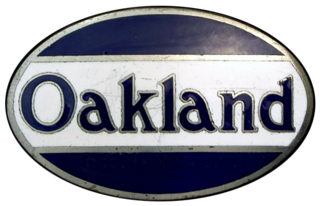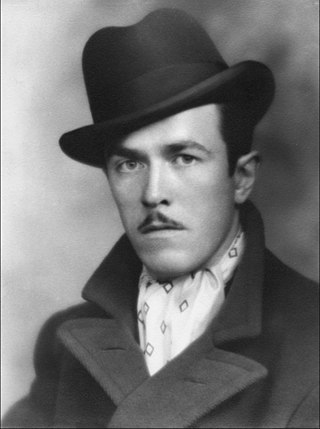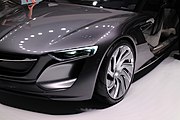
Lincoln Motor Company, or simply Lincoln, is the luxury vehicle division of American automobile manufacturer Ford. Marketed among the top luxury vehicle brands in the United States, until 2020, Lincoln was positioned closely against its General Motors counterpart Cadillac; however, beginning with the 2021 model year, they only offer SUV and crossover vehicles.

Cadillac Motor Car Division, or simply Cadillac, is a division of the American automobile manufacturer General Motors (GM) that designs and builds luxury vehicles. Its major markets are the United States, Canada and China. Cadillac models are distributed in 34 additional markets worldwide. Historically, Cadillac automobiles were at the top of the luxury field within the United States, but have been outsold by European luxury brands including BMW and Mercedes since the 2000s. In 2019, Cadillac sold 390,458 vehicles worldwide, a record for the brand.

The Continental Mark II is an ultra-luxury coupé that was sold by the Continental Division of Ford for the 1956 and 1957 model years. The first product line of Continental, the Mark II was developed as the worldwide flagship vehicle of Ford Motor Company. Developed as a successor for the 1939–1948 Lincoln Continental, the Mark II derived its nameplate from European manufacturing practice, denoting a second generation of the model family; Ford would later use this nomenclature for the Mark Series of flagship personal luxury cars.

A concept car is a car made to showcase new styling and/or new technology. They are often exhibited at motor shows to gauge customer reaction to new and radical designs which may or may not be mass-produced. General Motors designer Harley Earl is generally credited with inventing the concept car, and did much to popularize it through its traveling Motorama shows of the 1950s.

William L. Mitchell was an American automobile designer. Mitchell worked briefly as an advertising illustrator and as the official illustrator of the Automobile Racing Club of America before being recruited by Harley Earl to join the Art and Color Section of General Motors in 1935.
Virgil Max "Ex" Exner Sr. was an automobile designer for several American automobile companies, most notably Chrysler and Studebaker.

A fastback is an automotive styling feature, defined by the rear of the car having a single slope from the roof to the tail.

Daewoo Motors was a South Korean automotive company established in 1937 as "National Motors". The company changed its name several times until 1982 when it became "Daewoo Motors" following its acquisition by the Daewoo Group. After running into financial difficulties, it sold most of its assets in 2002 to General Motors at $1.2 billion, becoming a subsidiary of the American company. In 2011, the name "Daewoo" was definitively removed with the company being renamed GM Korea and the Daewoo brand replaced by the Chevrolet marque.

The tailfin era of automobile styling encompassed the 1950s and 1960s, peaking between 1955 and 1961. It was a style that spread worldwide, as car designers picked up styling trends from the US automobile industry, where it was regarded as the "golden age" of American auto design and American exceptionalism.

Harley Jarvis Earl was an American automotive designer and business executive. He was the initial designated head of design at General Motors, later becoming vice president, the first top executive ever appointed in design of a major corporation in American history. He was an industrial designer and a pioneer of transportation design. A coachbuilder by trade, Earl pioneered the use of freeform sketching and hand sculpted clay models as automotive design techniques. He subsequently introduced the "concept car" as both a tool for the design process and a clever marketing device.

Auburn was a brand name of American automobiles produced from 1900 to 1937, most known for the Auburn Speedster models it produced, which were fast, good-looking and expensive. However, after the 1929 Wall Street Crash, and the economic downturn that ensued, Auburn's expensive automobiles, along with its also very expensive sister marques Duesenberg and Cord, saw inevitable sales downturns, and all vehicle business halted in 1937.

The Oakland Motor Car Company of Pontiac, Michigan, was an American automobile manufacturer and division of General Motors. Purchased by General Motors in 1909, the company continued to produce modestly priced automobiles until 1931 when the brand was dropped in favor of the division's Pontiac make.

Automotive design is the process of developing the appearance of motor vehicles, including automobiles, motorcycles, trucks, buses, coaches, and vans.

Richard Arthur Teague was an American industrial designer in the North American automotive industry. He held automotive design positions at General Motors, Packard, and Chrysler before becoming Vice President of Design for American Motors Corporation (AMC), and designed several notable show cars and production vehicles including AMC's Pacer, Gremlin, and Hornet models, as well as the Jeep Cherokee XJ and either designed or assisted in the designing of later cars for Chrysler such as the Jeep Grand Cherokee and Neon after American Motors' buyout.
Joseph E. Oros Jr. was an automobile stylist for Ford Motor Company over a period of 21 years — known as the Chief Designer of the team at Ford that styled the original Mustang, and for his contributions to the 1955 Ford Thunderbird. Oros was also an artist, sculptor, painter and industrial designer, having designed appliances and other products.

Frank Stephenson is a Moroccan-born American automobile designer who has worked for Ford, BMW, Mini, Ferrari, Maserati, Fiat, Lancia, Alfa Romeo, and McLaren.

Ponton or pontoon styling is an automotive design genre that spanned roughly from the 1930s-1960s, when pontoon-like bodywork enclosed the full width and uninterrupted length of a car body — eliminating previously distinct running boards and articulated fenders. The integrated fenders of an automobile with ponton styling may also be called Pontoon fenders, and the overall trend may also be known as envelope styling.
Alexander Sarantos Tremulis was a Greek-American industrial designer in the North American automotive industry. Tremulis held automotive design positions at Cord Automobile, Duesenberg, General Motors, Tucker Car Corporation and Ford Motor Company before establishing a consulting firm.

Richard Henry Arbib was an American industrial designer.

Theodore Wells Pietsch II was an American automobile stylist and industrial designer who, with little formal education, managed to launch a career in automobile design that took him over a period of 38 years to nearly every major automobile company in the nation.



















